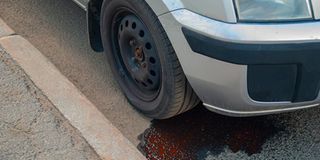How to identify liquid dripping from your car

What you need to know:
Have you ever walked up to your car and noticed there is a mystery puddle underneath it? Find out how to identify what is dripping under your car, whether it is dangerous, and what to do about it.
Look at any public parking spot and you will likely find spots of fluids. Sometimes, car leaks leave worrying spots or puddles on the ground that can make you wonder if your car is dying a slow death. Good news is, you can tell whether the fluid leak is a harmless drip or a serious problem to be fixed as soon as possible.
Consider this
Isaac Kabenge, a mechanic, says there are three things to consider when it comes to car leaks; colour, consistency, and location (so you can tell if the leak happened from the front or back of the car). There could be a number of different fluids seeping out, and they can come from a wide variety of locations. However, there are a few problem areas and weak spots which are a good place to start looking. Sometimes, it can be hard to track down the source of a leak, especially if the engine is dirty, as most are. Always check around and most importantly above the area where you see fluid deposits, as the liquid may have leaked from a different area, but pooled in a more visible location. Here is some good places to start looking, and a guide on what the liquid might be.
Engine oil
Engine oil is light brown to black and may be leaking out of the drain plug hole if the plug was incorrectly fitted or the gasket has failed. It could also be leaking from the sump gasket itself. Both of these leaks are low down on the engine so will often not leave oil pooling anywhere on the engine but the floor.
To check this location, get under the car and have a look around, say at a fuel station. Using a small flashlight will be helpful. There are other areas throughout the engine with seals such as the rocker cover whose seal might be giving way. If you have oil leaks, monitor the oil level closely until the source of the oil leak can be found and repaired. Running an engine low on oil can be a disastrously expensive mistake.
Gearbox oil
This is reddish and thin or brown and thick. While engine oil is usually the culprit of oily spots, it can also be gearbox oil. If gearbox oil is the offending liquid, it usually finds its way out through failed seals at the ends of the drive shafts. Basically, look around the area where the drive shaft enters the gearbox and check for runs from this point. Also, check the underneath of the transmission/gearbox to see if any other gaskets may have failed.
Coolant
It is usually yellow, green or pink and coolant leaks are relatively easy to identify due to its distinctive colour; almost always either red or green and of watery consistency. Leaking coolant often leaves white, powdery crystalline deposits in the area, or areas, it is leaking from. Weak spots in the cooling system, which are a good place to start the leak hunt are around the water pump, the hoses entering and exiting the radiator, around the thermostat housing, and the radiator itself.
Brake fluid
This is light brown and on a dirty car can look very similar to leaking engine oil. The key difference is the areas in which the leaks will be found. Any leak found near the wheel will almost certainly be brake fluid. Check the hoses entering the brake callipers and brake master cylinder. Since this is the kind of leak that requires immediate attention, Kabenge warns that for the sake of your safety and the safety of other road users, avoid driving a car with a faulty brake system.
Power steering fluid
This is similar to gearbox oil in colour. It is a hydraulic fluid, which may leak out of the pipe connections on the steering rack. It can leak from other areas, but this is a good place to start looking.
Fuel leaks are perhaps the most dangerous type of car leak since if left unattended to, they can cause a fire.
Fuel leaks generally make themselves known due to the strong and distinctive odour. If a fuel leak is expected, do not drive the car and have it fixed by a professional mechanic.
Water
Plain water could leak from the air conditioning system. It is no cause for alarm if the water drip is cool/cold. However, water leaks from the cooling system are harder to spot and when evident have already given way. If the water in your radiator keeps reducing, as this is a closed system, have it checked for leaks.
Caution
Isaac Kabenge, a mechanic, warns that any car leak can turn into an expensive repair if it is not dealt with quickly. Low levels of oil or coolant can lead to overheating and seizing of the engine, usually meaning a whole new engine is needed. If you find an oil leak, have it checked out by somebody who knows what they are doing.




